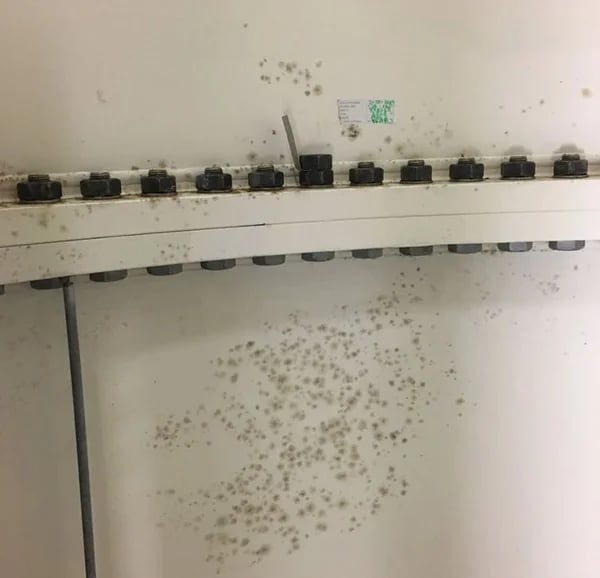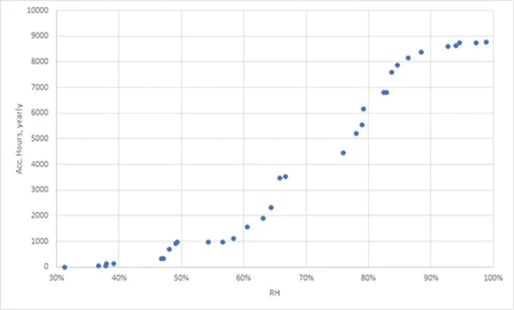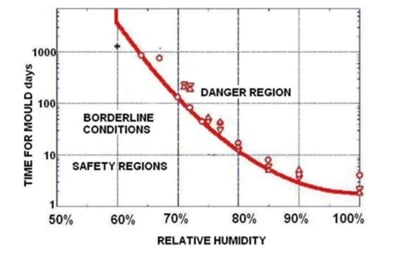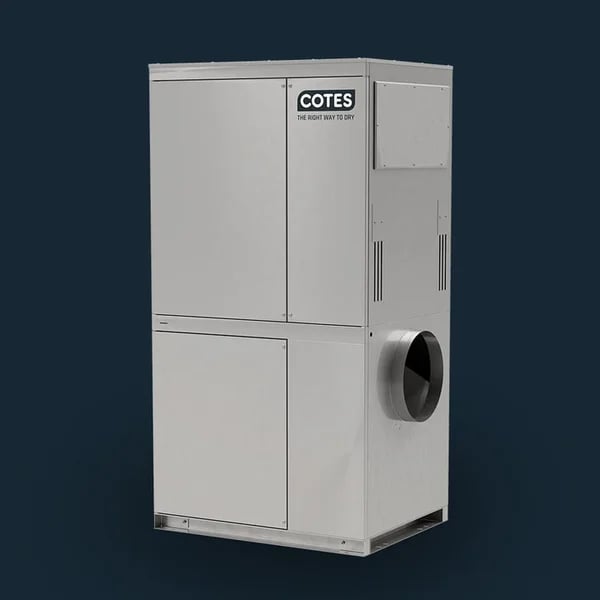The Akita and Noshiro wind farms are part of an offshore wind farm project off the coast of Japan that is currently being developed. Once the transition pieces (the bases of the turbines containing essential electrical equipment and where the tower and turbine are to be mounted) are installed, they will remain in place without the rest of the turbines for up to a year at the mercy of the prevalent humid weather conditions - a common concern within wind turbine maintenance: Safety and hygiene regulations dictate that the transition pieces need to be free of any condensation-related issues, such as mould or corrosion before the towers can be installed.
How do you avoid mould and corrosion from forming?
 Cotes’ was consulted to make just that decision; either invest in preventative measures to avoid any humidity-related problems in the first place or to do damage control afterwards. This report deals with the likelihood of mould and corrosion occurring in offshore wind turbines and how to prevent it.
Cotes’ was consulted to make just that decision; either invest in preventative measures to avoid any humidity-related problems in the first place or to do damage control afterwards. This report deals with the likelihood of mould and corrosion occurring in offshore wind turbines and how to prevent it.
The risk of having mould form in the transition piece should be a serious concern, as it negatively affects the health of people maintaining the turbines (monitored by QHSE departments) and compromises the integrity of the equipment as well as cause other wind turbine maintenance issues. Mould can occur in both onshore and offshore turbines. Still, the weather conditions, especially in locations such as this one, can have a bigger impact on offshore farms and cause high relative humidity levels in the transition pieces.
Evaluating / Benchmarking humidity levels
Based on the information we received from Akita and Noshiro, we were able to make assumptions about the possibility of mould growth in the transition pieces. The humidity in the environment of the wind farms is as shown in the graph below:

Figure 1: (Relative) humidity measurements from around the Akita and Noshiro wind farms
Figure 1 shows that the humidity levels are higher than 75% for more than 4,000 hours per year. This means that the relative humidity is more than 75% for 45,6% of the year, for which we consider the environment to be moderately susceptible to mould formation.
For the purpose of prevention, it is generally desirable to keep the relative humidity below 60% as this makes mould unlikely to occur at all, as can be seen in Figure 2. It demonstrates the number of days it takes for mould to form at different relative humidity levels.
In Akita’s and Noshiro’s case, the humidity levels are higher than 60% for 88,6% of the year, which is customary for such a climate. However, this also increases the risk of corrosion in the transition piece equipment, as the high humidity levels allow the saltwater to pass through the dehumidifier filters and accumulate within the transition pieces.
Maintaining the right conditions

Figure 2: Mould and humidity correlation (Source: https://www.canada.ca/en/conservation-institute/services/agents-deterioration/humidity.html )
As Figure 2 shows, without any measures to prevent mould formation due to high humidity, mould (and corrosion) will likely occur within as little as 30 days throughout 45,6% of the year (166 days). An additional concern is that the mould actually spreads faster if the humidity levels move in and out of the danger zone (Figure 2) regularly.
What does that mean for your wind turbines/ you?
As someone involved in the maintenance of a wind power business you should prioritise
- Keeping the relative humidity in and around your transition pieces below 60% to drastically reduce the likelihood of mould occurring
- Doing so consistently because the fluctuation of the humidity levels in and out of the danger zone will make mould formation more likely and is worse than not lowering humidity levels at all
- Manually interfering and implementing a dry-air solution that ensures the reliable upkeep of the conditions needed if you are in an area where it is not possible for you to naturally maintain levels below 60% humidity
What kind of solution is needed?

The two main concerns you now have for your transition pieces are mould and corrosion. You could take care of the former with a dehumidifier, but the high humidity in the outside environment would still lead to the salt from the adsorbed water to pass through the filters and cause corrosion. The corrosion itself could be remedied with a desalter that separates the salt from the water. An efficient, long-term solution should address both of these concerns.
Cotes innovative prevention method comprises desalting and dehumidifying in one dry-air solution that can be installed in the transition pieces before the construction on the towers has begun. The CWO models were specifically constructed to keep up with the conditions in offshore wind farms and are equipped with their own energy systems to keep the dehumidifiers running irrespective of weather conditions. The special setup allows for the air to be dehumidified before passing through the filter so that the salt crystallises and does not lead to corrosion within the transition piece equipment or compromise your wind turbine output.
In the case of the Akita and Noshiro wind farms, we were able to estimate that there would be a maximum leakage of 80m3/h air meaning the CWO26, the smallest model in the range, could be employed. With this solution, it is possible to keep the relative humidity below 60% for at least 90% of the year and have a maximum humidity of 75%, which significantly reduces the risk of mould in the foundations.
Optimally, the dehumidifier should be a part of the installation of the transition pieces from the beginning, to ensure the best possible results. Cotes has a wide range of industry-relevant dehumidifiers that can be used to effectively prevent mould from growing.
Making the right decision for your turbines and your business
%20(1).webp?width=600&height=424&name=Plakatbilleder%20uden%20logo_Page_04_Image_0001%20(1)%20(1).webp)
Cotes’ CWO line provides effective help for your wind turbine maintenance. In being proactive, you can eradicate an issue that would otherwise cost a lot of time and expenditure to fix in the future and pose a serious concern for workers and equipment alike, if not taken care of precisely and consistently. Prevention through a combination of desalting and dehumidifying allows you to rest assured that all possible issues are being taken care of for you, no matter the weather conditions, with reliable, long-term results. The benefits of this are abundant in reaching your optimal wind turbine output.
If you would like to know more about the risk of mould growth in comparison to the benefits of prevention or design your customised dry-air strategy together with one of our industry experts, feel free to book a consultation with Cotes or simply contact us per email or on LinkedIn.
Ready to start a conversation?
